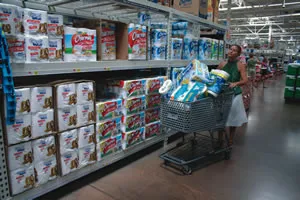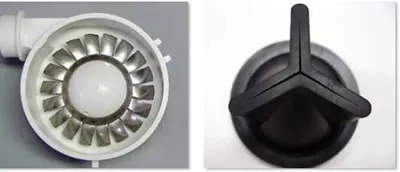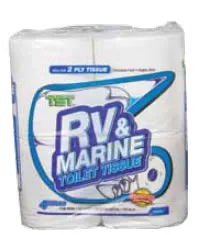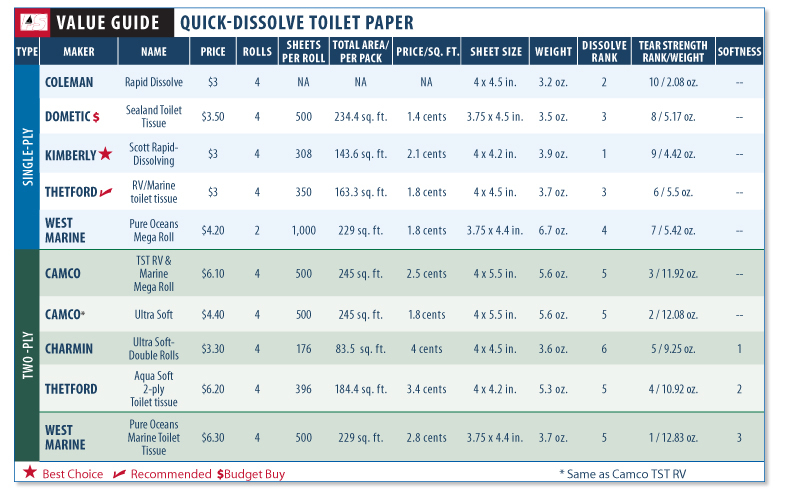
Photos by Dave Gill
Aah, just when you thought Practical Sailor had covered all marine issues, we found an interesting subject dear to your hearts, or bottoms. Something we all use every day, several times a day, and of concern to anyone with a marine toilet. Yes, we are talking about toilet paper, or as the manufacturers say toilet tissue.
After getting several letters from readers on this subject, we decided to follow up our reviews of electric marine toilets (PS February and March 2011) with a look at the best tissues available for use in these toilets and on-board sanitation systems.
At home, selection of what toilet tissue to purchase is swayed by the major brands marketing for softness. Some of us may remember Mr. Whipple and his squeezably soft Charmin. For marine and RV use, strength and price are also important, but since mobile sanitation systems are more vulnerable to clogs and dependant upon holding tanks, a tissue made of quickly dissolving material may be more important.
Whether manual or electric, a clogged toilet or a fouled holding tank is no fun aboard any vessel. Most manufacturers of marine toilets do not recommend use of standard toilet tissues. Some offer their own tissues. Those tissues that break up quickly and easily dissolve in water normally lack the adhesives of regular toilet tissue.
In addition, there are environmental issues. Every American goes through some 24 rolls of toilet paper per year, and that paper doesn’t just vanish when you flush the toilet. Consumers are looking for biodegradable materials that don’t unnecessarily introduce dyes and harsh chemicals into the waste stream.
Clogging of sanitary lines, pumps and valves is an issue in many areas. In the Caribbean, Pacific Islands, undeveloped counties, and aboard some charter, ferry, and fishing vessels, you are encouraged to use a separate wastebasket for tissues. Some extra-cautious owners install signs saying that the toilet accepts only items that have been eaten first.
Historically, the Chinese started using linen and paper products for their toilet use back in the 14th century. In the U.S., sheets of medicated paper were sold in the 1850s, but the mainstream introduction of toilet tissue began at the start of the 20th century when the Scott Paper Co. cornered the market. Scott, now part of Kimberly Clark, still dominates the market. The company makes tissue for several different private labels, some of the marine tissues among them.
For marine and RV use, the aim is to create tissue to be strong enough to hold together long enough to do its job then quickly fall apart. It also should be as soft as possible, and immediately dissolve in water.

Photos by Dave Gill
WHAT WE TESTED
Practical Sailor evaluated 10 toilet tissues from seven manufacturers: Coleman, Dometic, Kimberly, Thetford, West Marine, Camco, and Charmin. All are relatively well-known brands and readily available from local marine and RV distributors, or retail outlets. They are touted as being biodegradable, quick dissolving, and non-clogging. Prices vary significantly. One product was found under two different names, with one name selling for nearly 25 percent less than the other. It was no surprise that the marine product was the one with the higher price tag.
We did not attempt to test or verify all of the manufacturers claims (see How We Tested, above). For example, they all claim to be biodegradable. This is good, but open to wide interpretation. To an oil company, an oil spill in the Gulf is biodegradable, eventually.
Sunlight and bacteria will break down a lot of stuff that we put in the ocean, over many years. Most of our tested products claim to use recycled fibers with no specifics on where they come from, and some do not give what percentage is reused. Most say they are free of dyes and fragrance additives and many said they were septic-tank safe.
Greenpeace publishes a list of toilet papers that use post-consumer recycled paper. Only one of the products we tested, Charmin Ultra Soft, was on its list, but it was given a don’t buy rating because, according to Greenpeace, it contains no recycled materials.
While Coleman targets the camping market and West Marine is strictly a marine distributor, three of the companies manufacture sanitation products for both the marine and RV markets, and Scott is big in paper products. All of these products are specifically designed not to clog toilets. As mentioned, Charmin was added just to have a comparison with a major brand not claiming to be quick dissolving. Pricing can vary considerably between retailers, special offers on the Internet, and normal fluctuations in paper products.

Camco TST RV and MARINE
Marketed by camping and RV supplier Camco, the TST paper is sold through marine and RV outlets. It is exactly the same as the Camco Ultra Soft, which sells for about 25 percent less per packet. Touted to have no dyes or perfumes, and being fast dissolving and clog resistant, the TST paper was one of the strongest papers in our test.
Bottom line: Given its target market, the product was surprisingly slow to dissolve.

Charmin
We included Charmin Ultra Soft, made by Proctor & Gamble, as a benchmark and major supplier of standard toilet paper. It lived up to its reputation as the softest, whitest, and thickest. The rolls are light and fluffy, but had the fewest number of sheets per roll of our group. You are literally paying for air when you buy this product. It took four hours to dissolve, much longer than any other product.
Bottom line: Its as soft as Mr. Whipple says it is, but probably not the best thing for your holding tank.

Coleman
Part of the Coleman line of lanterns, camp stoves, and other camping supplies, this tissue was one of two we tested that are sold in a re-sealable plastic pouch. A rainy campout is bad enough, but wet or even damp TP is a mess, especially this brand, which seems to easily disintegrate in water. This four-pack is advertised as rapid-dissolve and biodegradable. This was the only product that did not give the buyer any clue as how much paper they were getting for their money. Most products listed not only the total square feet of paper in the package, but also the size of the sheets and how many sheets were in each roll. Coleman did not even list the weight of the package.
This was the lightest roll in our comparison. It was only slightly lighter than the Scott, which held about 300 sheets per roll. It was the second fastest to dissolve and tore the easiest.
Bottom line: Colemans paper dissolves quickly, but you don’t appear to get much paper for your money.
Dometic
Dometic manufactures an extensive line of marine toilets and sanitation systems. The company specifies its Sealand rapid dissolving, single-ply toilet tissue for its toilets and sanitation devices. This toilet paper landed in about the middle of our group in terms of strength and ability to dissolve in water and is affordably priced. We found it for $3.49 at Defender online, list as “ComfortCare” toilet paper making it our Budget Buy.
Bottom line: Dometic TP works as designed, and it’s roll of 500 sheets should a little longer than Thetford for those who are counting sheets. This is our Budget Buy.
Thetford
The Thetford RV/Marine, single-ply tissue also claims to dissolve quickly and to be biodegradable. Thetford has an extensive line of toilets, chemicals, holding tank accessories and refrigerators for both marine and RV use.
These rolls were lightweight, tore easily, dissolved quickly, and were inexpensive. Thetfords Aqua Soft two-ply is a little heavier, stronger, and much softer. It does not dissolve as well.
Bottom line: Thetfords single ply was the third-fastest dissolving paper. Buy it from an RV store, where itll be sold much cheaper than at a marine outlet.
West Marine
The Pure Oceans Marine toilet tissue in the single-ply, 1,000-sheet Mega Roll was the heaviest single-ply we tested. These rolls come individually wrapped in re-sealable plastic pouches-a nice idea if you sail in a damp climate.
The two-ply Pure Oceans Marine Premium Ultra Soft toilet tissue came in a 500-sheet roll. It is also sold in a re-sealable pouch.
These two products from West Marine seem to be made of the same paper, but one is in a two-pack of 1,000 sheet single-ply rolls and the other is in a four-pack with 500 sheet, single-ply rolls.
These turned out to be one of the softest, largest, heaviest and strongest of the marine tissues. They were also near the bottom of our test group in ability to dissolve, but definitely better than standard toilet paper.
Bottom line: Soft, heavy, and strong, the West Marine TP just doesn’t dissolve as quickly as some other marine papers.
Scott
Scotts Rapid Dissolving tissue (made by Kimberly Clark) made for RVs and boats was the fastest-dissolving product in our test. It wasnt a very strong paper, but it got the job done. Sheets were relatively thick, and in terms of dollars per ounce, it was a pretty good value.
Bottom line: This is our Best Choice and one of the cheapest, a rare sweep.
Conclusions
When all the scientific data was crunched, Practical Sailor had to give the nod to Scotts Rapid Dissolving Tissue as it was truly the fastest to break up and dissolve in water. Thetfords toilet tissue was a close competitor.
Any of the marine and RV fast-dissolving tissues we evaluated would be better for your on-board toilet than standard TP. The main way to prevent problems is to always have enough water in the bowl and do not use globs of tissue before flushing.






































